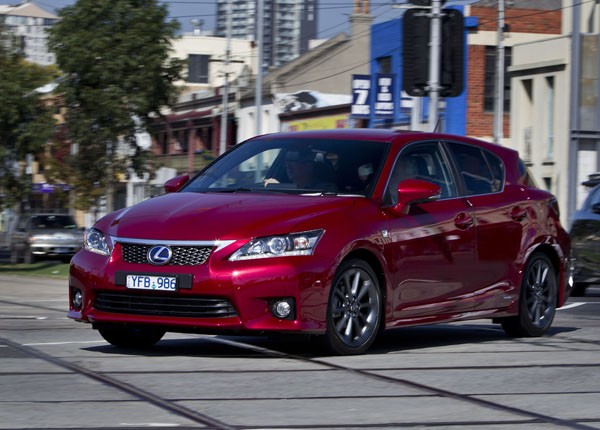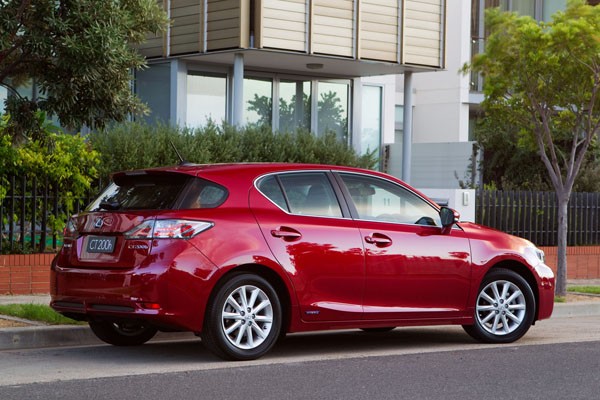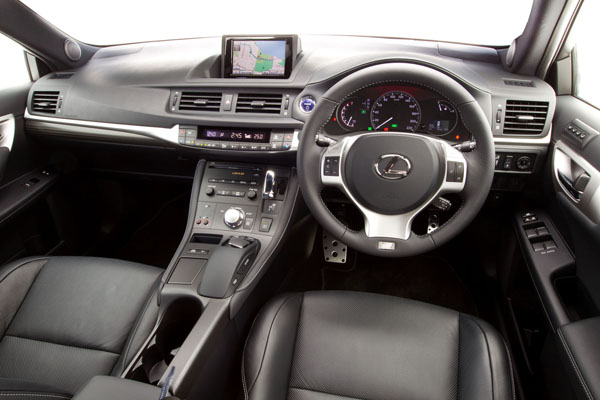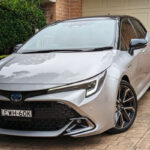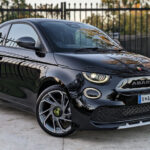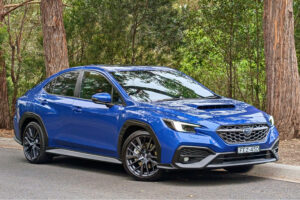Ecologically speaking, Lexus, like its parent company Toyota, has nailed its future firmly to the hybrid powertrain tree, Lexus sedan and sports utility vehicles being early adopters of the petrol / electric hybrid system.
In 2010 the company came up with the CT200h Compact Touring hybrid hatch, the first of its type on the market. At less than $50,000, it provides an ideal introduction to the upmarket marque.
With the help of the Lexus L-Finesse design philosophy the car has evolved into a vehicle that lives out the intended ‘Creative Touring’ CT of its title.
It comes to market in Australia in three versions – CT200h Luxury, F Sport and Sports Luxury, together with up to four Enhancement Packs, cost options which add individual touches across the board.
Prices start at $45,049, with nothing more to pay, for the Luxury variant and climb to $62,389 for the Sports Luxury on the road. Our test car was the latter, which included goodies such as Active Cruise Control plus a Pre-Collision Safety System, auto-levelling LED headlamps, parking sensors front and rear and 13-speaker Mark Levinson audio.
STYLING
On three sides the CT200h follows the standard small hatchback design script with characteristic architecture. However, when it comes to the front, the car makes a forceful statement. Front and centre is the Lexus signature spindle radiator grille with its broad-shouldered upper region, pinched in waist and wide base. Each model has its own mesh design, the Sports Luxury we tested incorporating horizontal lines.
Latest generation LED headlamps flank the radiator’s upper edge and incorporate an L-shaped set-up of daytime running lights.
Power exterior mirrors carry a rain dispersing coating and include puddle lights which turn on as the door is opened. Seventeen-inch twin spoke alloy wheels fill out the wheel arches and are shod with Yokohama ‘dB decibel’ tyres to tone down road noise as befitting a luxury tourer.
The cabin boasts a 10-way power adjustable driver’s seat with memory.
Rear seat legroom takes a step back with limited space that’s really only suited to children unless those in the front are able to move their seats a fair way forward. You get nothing for nothing in this world and current hybrids demand large batteries that inevitably steal space from somewhere.
Instruments and controls are split into two areas, an upper Display Zone, meaning there’s minimum eye movement from the road, and lower Operation Zone, placing controls close at hand.
INFOTAINMENT
A range of options, including climate control air-conditioning, audio settings and standard satellite navigation in the Sports Luxury model, is easily accessed by means of a Lexus Remote Touch Controller, a joystick on the centre console linked to a full-colour display on a screen centrally mounted on the top of the dashboard.
This is also the key to Lexus Enform, which when programmed with a location will seek out such things as accommodation on the way with the closest petrol stations. It can even make hotel reservations.
Entertainment is in the hands of premium Mark Levinson 13-speaker sound system, digital radio, a DVD player, plus two USB inputs.
ENGINE / TRANSMISSION
The Lexus Hybrid Synergy Drive combines two energy sources – a 1.8-litre petrol engine and electric motor – into one efficient and versatile operation, power being put to ground through a continuously variable transmission (CVT).
Drive Mode Select mates the car with the driver’s mood at the twist of a knob located at the base of the centre stack. EV mode has the car slipping along in silence up to 45 to 50 km/h on electric power alone with interior lighting a soothing blue; ‘Eco’ mode brings in the petrol engine and maintains a relaxed driving style.
‘Normal’ adjusts throttle response resulting in driving suited to city congestion. Switch to ‘Sport’ and everything snaps to attention; lighting turns red and the hybrid meter becomes a tacho as the car morphs into a high performance hatch to match.
SAFETY
As well as eight airbags, many of the CT200h safety systems have been lifted from the much more expensive Lexus flagship models, resulting in a five-star ANCAP safety rating.
Vehicle Stability Control, for example, uses engine output and braking on each individual wheel, together with traction control, to intervene if it senses the car is skidding due to oversteer or understeer, probably as the result of poor driving.
The Sports Luxury model also features a Pre-Collision Safety System, which detects if a crash is imminent. It displays a warning and sounds an alarm, adjusts the seatbelts for greater restraint and sets the Brake Assist system to full braking.
Also fitted is Active Cruise Control which keeps the car at a predetermined time from a vehicle in front by slowing the CT200h to keep a safe gap. It speeds the car up when the vehicle in front accelerates or moves out of the way.
Safety extends to the rear with a reversing camera, and guidelines marking the car’s track.
DRIVING
Keyless entry has the driver settling into a seat in one of a range of pre-programmed driving positions. Pushing the engine power button results in … silence; the only indication of powering up, the illumination of the word ‘Ready’.
The electric motor gets the vehicle off the mark almost instantaneously, thanks to the maximum torque on tap from the word go; the petrol engine chimes in when the car is under way.
The CT200h is the first Lexus to incorporate Drive Mode Select, a credit to 21st century automotive technology that can make a sluggish, if ecologically friendly, small car in ‘Eco’ become a road-going all-rounder (Normal), then morph into an exciting hot hatch (Sport) all at the turn of a knob.
‘Normal’ is the default mode and really is middle-of-the-road motoring best left to the computers to helping the car pick its way through the varying traffic conditions of the city CBD and suburbs.
On test the CT200h paid dividends by quietly consuming an average of 5.9 litres of petrol per 100 kilometres in town and sipped 3.8 litres on the motorway, the Yokohama ‘dB decibel’ tyres taking the intrusive drumming out of the latter’s concrete contact with rubber.
In conditions that cried out for a little more spice to be added to the mix a final twist of the control knob to “Sport’ had the hatch making the leap into heightened awareness – the electric motor adding power, the throttle and steering becoming more responsive, the Vehicle Stability and Traction Control taking in fresh orders from the computers to spur on the car to a more athletic performance.
A feature that is being taken up by more sat nav systems these days is the ever-so-sensible ding-dong ‘Avon calling’ bell and verbal warning when approaching a 40 km/h school zone, or red light camera. The CT200h obliges with both.
All, however, is far from perfection. The dash-mounted screen is susceptible to disturbing reflection in bright sunlight, partially obscuring important information. More work is needed here.
SUMMING UP
Of the car companies that initially took on the European luxury marques late last century – Lexus (Toyota), Infiniti (Nissan) and Eunos (Mazda) – Lexus is the only one to have followed through with any great success.
I look forward to further CT200h developments; price cuts, perhaps.
AT A GLANCE
MODEL LINE-UP
Lexus CT200h Luxury: $45,049 (driveaway)
Lexus CT200h F Sport: $54,229 (driveaway)
Lexus CT200h Sports Luxury $62,389 (driveaway)
(A series of Enhancement Packs are available for each model as a cost option)
FEATURES
1.8-litre 100 kW Hybrid Synergy Drive (standard)
Continuously variable transmission
ABS anti-skid braking with Electronic Brake-force Distribution and Brake Assist, Vehicle Stability Control, Traction Control. Hill Start Assist
Emergency (flashing) brake lights
Multi-Information Display with trip computer
Rear-view camera
Tacho, Eco gauge and Drive Mode linked mood lighting
Dusk sensing headlights
Daytime running lights
Drive Mode Select – EV, Eco, Normal and Sport
Dual zone climate control
Bluetooth mobile phone connectivity with audio streaming
16-inch alloy wheels
Active cruise control (Sports Luxury)
Pre-Collision Safety System (Sports Luxury)
Front and rear parking sensors (Sports Luxury)
10-way power driver’s seat with electric lumbar support (Sports Luxury)
LED low beam headlamps with auto levelling (Sports Luxury)
Smart key entry and engine start (Sports Luxury)
Mark Levinson 13-speaker audio system (Sports Luxury)
SPECIFICATIONS:
Capacity: 1.798 litres
Configuration: Atkinson Cycle in-line 4-cylinder
(Electric Motor)
650-Volt Permanent Magnet Synchronous
Maximum Power: 100 kW
Maximum Torque (electric): 207 Nm
Maximum Torque (petrol): 142 Nm @ 2800-4400 rpm
Hybrid system: Series / parallel
High voltage battery: Nickel-Metal Hybrid
Nominal voltage: 2016
DRIVELINE:
Drivetrain: Lexus Hybrid Drive, front-wheel drive, electronically controlled continuously variable automatic transmission
DIMENSIONS, WEIGHT AND CAPACITIES:
Length: 4350 mm
Width: 1765 mm
Height: 1455 mm
Wheelbase: 2600 mm
Ground clearance: 140 mm
Kerb weight: 1410-1465 kg
Gross vehicle mass: 1845 kg
Seating capacity: 5
Cargo capacity 375 litres
Fuel Tank Capacity: 45 litres
Turning circle: 10.4 m
SUSPENSION AND BRAKES:
Suspension: MacPherson strut bar (front); double wishbone (rear)
Brakes: Ventilated discs (front); solid discs (rear). ABS anti-skid brake system with Electronic Brake-force Distribution, Vehicle Stability Control. Traction Control
Steering: Electric power assisted rack and pinion
Wheels / tyres: Alloy 17 x 7 / 215/45 R17. Space saver spare
PERFORMANCE
Acceleration 0 to 100 km/h: N/A
Top speed: N/A
FUEL CONSUMPTION:
Fuel type: 95 RON unleaded
Combined Cycle (ADR 81/01): 4.1 litres per 100 km. CO2 emissions 95 g / km
GREEN VEHICLE GUIDE RATINGS:
Greenhouse Rating: 9.0 / 10
Air Pollution Rating: 8.5 / 10
WARRANTY:
4-year / 100,000 kilometres, plus Lexus Encore Program
8-year / 160,000 kilometres (hybrid battery)




